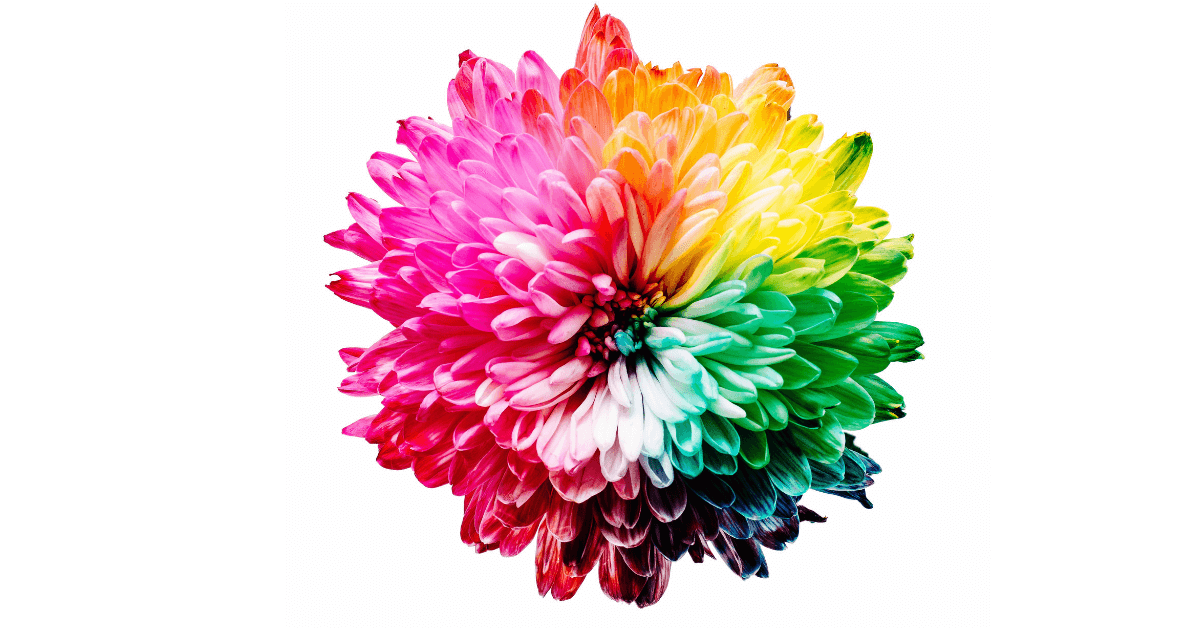
What Color Is Your Relationship?
There are the Five Love Languages outlined in Gary Chapman’s book that describes the ways we like to feel loved and appreciated. There could also be the five colors of relationship designated for different relationship states. Blue for distant. Red for conflictual. Yellow for competitive. Black for dead, and white for peaceful. These are of course made up and random.
`
What is helpful, however, is not determining the color of your relationship, rather it is understanding that the color of your relationship is a reflection of the color of the two people in it. I am not talking about skin color. It is a metaphor. The color represents the feeling state of the relationship, and to borrow a metaphor from George Pransky, the feeling state of the relationship is a combination of the combined feeling states of the two people in it.
The reason this is helpful is because it points to how the quality of a relationship changes. It demonstrates that there is no point in working on a relationship because the quality of a relationship is simply a reflection of the state of mind of the two people in the relationship. And reveals the hopefulness in seeing that if one person in the relationship shifts, the quality of the relationship can’t help but be impacted because the feeling quality of a relationship is based on the feeling state of the individuals in the relationship.
Understanding this directs us to why understanding how the mind works is ultimately what is most useful in relationships. When we understand how our psychological functioning works we are less scared by it and less likely to act out from our fear with our loved ones. And if you are experiencing relationship challenges, you know the first place to look is to your own state of mind and experience of your own wellbeing rather than outside of yourself.
When the state of mind of one person in the relationship changes the quality of the relationship is always impacted. If you mix yellow and blue together you get green. If you mix red and blue together you get purple. Even if the blue stays constant, the mixed color changes. So even if only one person changes in the relationship, the quality of the relationship will shift. This is freeing and empowering. You can enjoy your relationship independent of your partner’s moods.
To take it one step further, you don’t ever experience “your relationship”. You only have your subjective experience of the relationship constructed out of your perception. And to take it another step further the you who perceives the relationship is made up as well. Our sense of self is created moment to moment via thought. We are not solid and fixed. We are fluid like thought. You are experiencing the creation. Who is the you that is experiencing? I don’t know. Some use labels like consciousness and God, but to me, it is a mystery — the mystery.
How is this helpful to relationships? Angus would probably be getting frustrated with me now if we were having a conversation saying, “What’s the point? This is nihilistic! You’re just getting caught up in your head!”
But I do think it is helpful and important. Sydney Banks said we live in a world of thought. We live in a psychological experience from the cradle to the grave. But he also said we live in two worlds — the formless and the form, and they are both real. We have a psychological experience that feels real, but it is not all of who we are. It is an experience we have. An experience of individuality, of separation, of form that is created from the formless. It happens.
When I understand even just a little bit that I experience the subjective and fluid nature of my experience, I hold it more lightly.
This helps me to move through the rainbow of my emotional experience with more grace and ease. Seeing this helps me to remember when I feel upset with someone, I am experiencing my color of emotion and not them.
This is when the big buts come my way:
But he did:
- stop talking
- behave cruelly
- betray me
But she did:
- lose her temper
- cheat on me
- criticize me
But, but, but…
Yes, these things do happen, and there seem to be generalized ways people feel when these kinds of things happen. But seeing where my experience comes from reduces my suffering. When I understand my experience is temporary, I don’t resist it. When I know it comes from the meaning I am creating, I don’t feel like a victim even when I don’t condone the behavior.
Angus and I have been irritable with each other this week. He would have the experience of me being stern or critical and react. Then I would have the experience of him being angry. I would then feel disappointed. It looked like life would be more fun if he were different or if I were different.
What helped me most now compared to how I was in the past is that I did not take my experience or his behavior seriously. I did not make it mean anything about our relationship. I knew it would pass. My safety and wellbeing weren’t threatened even though I felt upset. There were no high stakes. Nothing was at risk. We were each having our human experience. And our human experiences were doing what they do, going up and down, and in and out of good feelings.
Understanding that my experience is made up and fluid, that even my sense of self is made up and fluid helps me to take myself and life much less seriously. In particular, it makes relationships more lighthearted and fun versus painful and difficult.
And this is the color I bring to our relationship. A lighter color, more translucent and soft versus the dark tones I used to show up with. This makes going through all of the colors of the rainbow more fun and less burdensome. And there is a deeper appreciation for the colorless medium from which the colors arise like a prism. Everything I was looking for is there. It doesn’t matter that the nature of experience is to change when I feel the reassurance of something unchanging. I don’t need to do anything to change or resist what is. I have everything. I need in the moment even when it feels like I don’t.
If you want to change the quality of your relationship, look toward understanding the fluid nature of your own experience. Any suffering you are experiencing is not the relationship’s fault or your partner’s fault. It isn’t even your own fault. It is simply the result of you being caught up and identifying with your negative experience. This is completely normal and human, but you will not stay stuck there. You will always be free-flowing and fluid. You can relax and stop trying to change that or get something to stay one way. This is such a relief and in the letting go, you relax into the creative potential of who you are and feel the freedom of having your experience created fresh.
We suffer when we resist this. We suffer when we try to fix ourselves, make things fixed, change what is, improve ourselves, improve our relationship. It is often so invisible to us that we are doing it but knowing we create it makes it easier for us to ride out our self-generated suffering.
We may not be able to stop hitting ourselves on the head, but we know we will eventually stop so we ride it out, knowing it is us all along anyway. Not dwelling on my negative thinking helps me to feel the deeper part of myself that cannot be hurt or broken. I feel reassured knowing I am okay no matter what happens in my life because I am not my personal psychology. I have the experience of it, but I am much greater than that, and so are you!
Rohini Ross is passionate about helping people wake up to their full potential. She is a transformative coach, leadership consultant, a regular blogger for Thrive Global, and author of the short-read Marriage (The Soul-Centered Series Book 1) available on Amazon. You can get her free ebook Relationships here. Rohini has an international coaching and consulting practice based in Los Angeles helping individuals, couples, and professionals embrace all of who they are so they can experience greater levels of well-being, resiliency, and success. She is also the founder of The Soul-Centered Series: Psychology, Spirituality, and the Teachings of Sydney Banks. You can follow Rohini on Facebook, Twitter, and Instagram, and watch her Vlogs with her husband. To learn more about her work go to her website, rohiniross.com.



 Chip Chipman – The Simplicity of Syd’s Teachings
Chip Chipman – The Simplicity of Syd’s Teachings Spiritual Facts
Spiritual Facts  Christine Heath & Judy Sedgeman – Spirituality and Resilience
Christine Heath & Judy Sedgeman – Spirituality and Resilience
 Rohini Ross
Rohini Ross Are you self-critical, hard on yourself, and constantly trying to “fix” whatever you think is wrong with you? Perhaps you have tried all kinds of different personal growth techniques and spiritual practices in the hope of solving all your problems. This cycle can be exhausting and never-ending, because there will always be something to improve about yourself, from that mindset. Sydney Banks’ teachings can help you to see how your humanness is normal and not something that needs fixing: as a spiritual person, you don’t need to change or eradicate your humanness! Seeing yourself as normal allows you to love and accept yourself exactly as you are—warts and all. Adopting this perspective naturally brings out the best in you and helps to find peace with your personality. Self-love and self-acceptance is your natural state, and any disconnection from your true nature is only temporary. What a relief!
Are you self-critical, hard on yourself, and constantly trying to “fix” whatever you think is wrong with you? Perhaps you have tried all kinds of different personal growth techniques and spiritual practices in the hope of solving all your problems. This cycle can be exhausting and never-ending, because there will always be something to improve about yourself, from that mindset. Sydney Banks’ teachings can help you to see how your humanness is normal and not something that needs fixing: as a spiritual person, you don’t need to change or eradicate your humanness! Seeing yourself as normal allows you to love and accept yourself exactly as you are—warts and all. Adopting this perspective naturally brings out the best in you and helps to find peace with your personality. Self-love and self-acceptance is your natural state, and any disconnection from your true nature is only temporary. What a relief! In our culture, success is often associated with hard work and narrowly defined as material gain. However, authentic success, as shared by Sydney Banks, includes such intangibles as happiness, well-being, love, joy, compassion, and peace of mind that are innate in each one of us, along with outward goals and achievements. It honors the whole person in all walks of life, whether you are a professional, leader, executive, solopreneur, employee, mother, teacher or student. From this knowing and experience, you can access the infinite wellspring of love that is your essence, then share your gifts with the world from a place of fulfillment and meaning, through a profound understanding of the interaction between your psychological and spiritual natures. While conventional success can deplete you, authentic success only fills you up.
In our culture, success is often associated with hard work and narrowly defined as material gain. However, authentic success, as shared by Sydney Banks, includes such intangibles as happiness, well-being, love, joy, compassion, and peace of mind that are innate in each one of us, along with outward goals and achievements. It honors the whole person in all walks of life, whether you are a professional, leader, executive, solopreneur, employee, mother, teacher or student. From this knowing and experience, you can access the infinite wellspring of love that is your essence, then share your gifts with the world from a place of fulfillment and meaning, through a profound understanding of the interaction between your psychological and spiritual natures. While conventional success can deplete you, authentic success only fills you up. Your ability to enjoy life comes from being present in the moment rather than caught up in habitual, negative thoughts that take you out of the Now. Sydney Banks’ wisdom supports you in becoming aware of how you get seduced by your limited personal thinking and thus, create a painful reality of misunderstanding, fear and restriction. When you recognize how and why this happens, you can step free of the pattern. This understanding assists you to dismiss unhelpful thoughts and not take them seriously. Unlike traditional self-help or therapy, experiencing more psychological freedom and enjoyment does not rely on techniques. There are no magic bullets on the path of well-being. All you need to do is follow an internal compass that points to the truth of who you really are—beyond transient thoughts to your unchanging, formless essence.
Your ability to enjoy life comes from being present in the moment rather than caught up in habitual, negative thoughts that take you out of the Now. Sydney Banks’ wisdom supports you in becoming aware of how you get seduced by your limited personal thinking and thus, create a painful reality of misunderstanding, fear and restriction. When you recognize how and why this happens, you can step free of the pattern. This understanding assists you to dismiss unhelpful thoughts and not take them seriously. Unlike traditional self-help or therapy, experiencing more psychological freedom and enjoyment does not rely on techniques. There are no magic bullets on the path of well-being. All you need to do is follow an internal compass that points to the truth of who you really are—beyond transient thoughts to your unchanging, formless essence. Greater psychological freedom is the gift that keeps on giving. How grateful would you feel if you no longer had to listen to your negative, self-punishing and painful inner narrative, day in and day out? Understanding the role of thought and recognizing how it creates your feelings of insecurity and self-doubt is truly liberating! You will be better able to hear and heed your inner wisdom and become less driven by the noisy thoughts of fear and constriction. As an ongoing practice, this allows you to more fully experience your resilience and reach a greater sense of clarity about how you want to move forward in your life. As a result, you can live in a way that feels authentic and true in every area, including your career, family, home, creative expression, play, relationships and overall well-being.
Greater psychological freedom is the gift that keeps on giving. How grateful would you feel if you no longer had to listen to your negative, self-punishing and painful inner narrative, day in and day out? Understanding the role of thought and recognizing how it creates your feelings of insecurity and self-doubt is truly liberating! You will be better able to hear and heed your inner wisdom and become less driven by the noisy thoughts of fear and constriction. As an ongoing practice, this allows you to more fully experience your resilience and reach a greater sense of clarity about how you want to move forward in your life. As a result, you can live in a way that feels authentic and true in every area, including your career, family, home, creative expression, play, relationships and overall well-being. When you no longer give authority to the fear-based thoughts in your consciousness, all you are left with is happiness. Through the teachings of Sydney Banks, you can see how your psychological functioning works, which makes you less compelled to follow those thoughts that do not serve you. Becoming more aware of the wholeness and integration of both your human and spiritual natures helps to ground you in the unchanging essence of who you are, and ride out the ups and downs of your emotional experience more gracefully. Accepting the normalcy of your humanness will naturally reduce your anxiety and fear and enhance your joy and happiness in each moment. By placing less pressure on yourself to feel a certain way or be hung up on self-improvement, you may find that low moods do not derail or debilitate you; instead, you will become much more attuned to your innate wellbeing and peace of mind and experience more happiness as a result.
When you no longer give authority to the fear-based thoughts in your consciousness, all you are left with is happiness. Through the teachings of Sydney Banks, you can see how your psychological functioning works, which makes you less compelled to follow those thoughts that do not serve you. Becoming more aware of the wholeness and integration of both your human and spiritual natures helps to ground you in the unchanging essence of who you are, and ride out the ups and downs of your emotional experience more gracefully. Accepting the normalcy of your humanness will naturally reduce your anxiety and fear and enhance your joy and happiness in each moment. By placing less pressure on yourself to feel a certain way or be hung up on self-improvement, you may find that low moods do not derail or debilitate you; instead, you will become much more attuned to your innate wellbeing and peace of mind and experience more happiness as a result. One of the first areas people often experience profound transformation from the teachings of Sydney Banks is in their relationships, both personal and professional. While it often seems like another person’s irritation, anger, indifference, insensitivity, rudeness, etc., directly affects your experience, in reality your disturbance is a product of your own individual thinking. By making someone else responsible for how you feel, that person automatically becomes the cause of your suffering. Once you understand that you always have a place of well-being inside, independent of another’s behavior, it is easier to maintain equanimity through their changing moods and behaviors. Romantically, you may experience deeper love and intimacy with your partner, but the teachings benefit all relationships. This awareness supports more authentic connection and expression, while facilitating greater understanding, improved communication, reduced reactivity, more acceptance of self and others, and improved ability to work out differences and find common ground. Best of all, just one person shifting in a relationship is enough to transform it.
One of the first areas people often experience profound transformation from the teachings of Sydney Banks is in their relationships, both personal and professional. While it often seems like another person’s irritation, anger, indifference, insensitivity, rudeness, etc., directly affects your experience, in reality your disturbance is a product of your own individual thinking. By making someone else responsible for how you feel, that person automatically becomes the cause of your suffering. Once you understand that you always have a place of well-being inside, independent of another’s behavior, it is easier to maintain equanimity through their changing moods and behaviors. Romantically, you may experience deeper love and intimacy with your partner, but the teachings benefit all relationships. This awareness supports more authentic connection and expression, while facilitating greater understanding, improved communication, reduced reactivity, more acceptance of self and others, and improved ability to work out differences and find common ground. Best of all, just one person shifting in a relationship is enough to transform it. Clare Dimond
Clare Dimond Scott Kelly
Scott Kelly Barbara Patterson
Barbara Patterson Barbara Patterson
Barbara Patterson Michael Neill
Michael Neill Dicken Bettinger – The Spiritual Nature of the teachings of Sydney Banks
Dicken Bettinger – The Spiritual Nature of the teachings of Sydney Banks Elsie Spittle – The Soul of the Principles
Elsie Spittle – The Soul of the Principles
Heather Daly
17.05.2019 at 16:56I just love this analogy with the colors! I really so appreciated what you said about the feel of a relationship being the combined feeling tone of each individual in it. It is so simple, but so empowering and clarifying too! Thank you for this!
Rohini
20.05.2019 at 12:08Thanks for your comment, Heather! Glad you found the metaphor helpful! 🙂